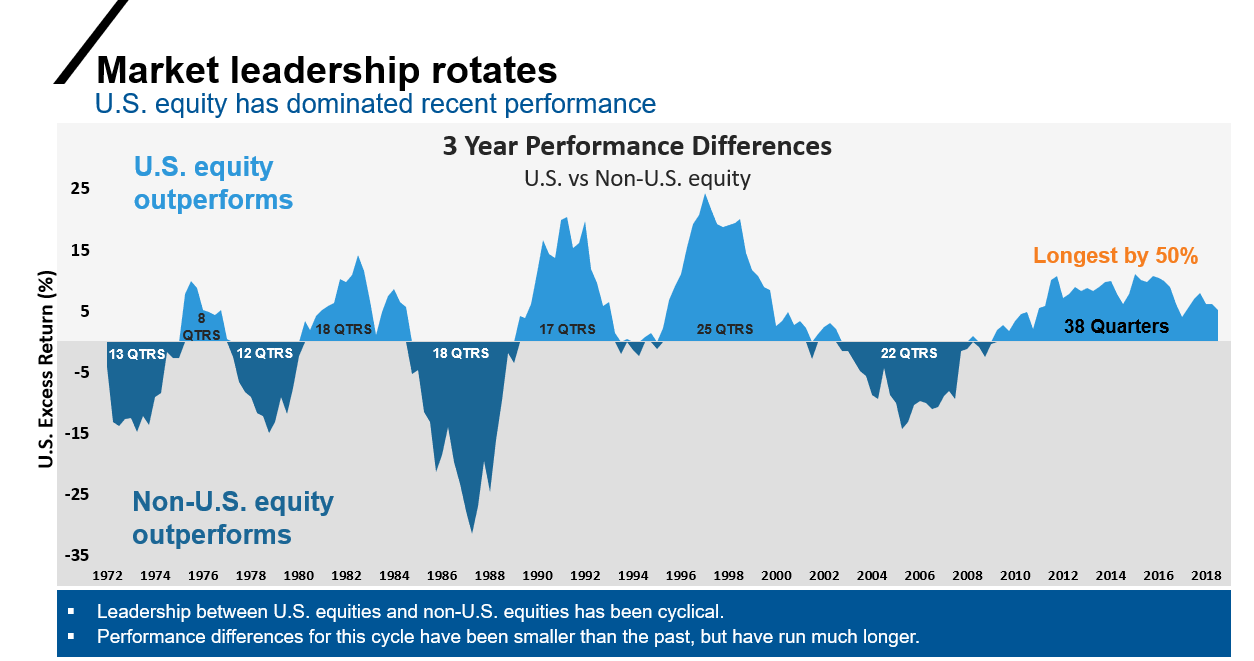Diversification: A potential cure for emotional investor behavior?
The concept of diversification is nothing new for investors. The adage “don’t put your eggs in one basket” simply states why diversification is vital. There are several potential benefits of a diversified multi-asset investment portfolio, and one of the most important is to reduce concentration risk. This is done in a number of ways, but primarily by investing in a variety of asset classes, industries and geographies. Additionally, diversification may help smooth out returns in volatile times, it may provide for higher returns over longer time periods and it may help investors avoid the pitfalls of emotionally based investment decisions.
Concentration risk
Concentration risk is essentially the risk from investing in a single asset class or single region. A diversified multi-asset portfolio typically has exposure to a variety of asset classes as well as regions. History has demonstrated that all asset classes have market cycles where they perform well and cycles where they trail. Additionally, history has shown some asset classes are going to do well when others are lagging. For instance, commodities tend to be an asset class with a lower correlation to U.S. equities. Since it is nearly impossible to predict which asset classes are going to lead or trail in any given year, and we have seen that asset classes can go from leaders to trailers suddenly and with little to no warning, we believe it is important to stay diversified and stay invested over the long-term.
Market leadership rotation
Most recently, investors have noted the value of owning U.S. stocks. Looking at the chart below, we see U.S. equities have outperformed non-U.S. equities for the last 37 quarters! However, a couple of things that are evident in this chart are the abrupt shift that occurs when leadership rotates, and that leadership does indeed rotate.
Click image to enlarge
Index returns represent past performance, are not a guarantee of future performance, and are not indicative of any specific investment. Indexes are unmanaged and cannot be invested in directly.
Source: Morningstar Direct; US Equities: S&P 500 Index, Non-US Equities: MSCI World ex USA.
May help smooth out returns in volatile times
In addition to the idea that diversification may help protect a portfolio’s return when asset class leadership rotates, it also may help smooth out a portfolio’s return when market volatility increases. A properly diversified portfolio may have lower drawdowns and reduce risk over the long-term. That said, a balanced return may be less than the best performing asset class and better than the worst.
In the chart below, we can see a visual representation of this. In the second half of 2018, there was a significant market correction that saw Canadian stocks, represented by the S&P/TSX Composite Index, fall 11.6%. However, for the same period, a balanced allocation comprised of Canadian, U.S., and international stocks as well as fixed income, was only down 4.7%. As markets rebounded in Q1/Q2 2019, Canadian stocks recovered 16.2% and the balanced portfolio returned 10.3%. In both instances, the balanced portfolio exhibited less volatility than Canadian stocks, but by the end of June 2019, it provided a cumulative return since the beginning of 2018 of 8.7% versus 5.9% for the S&P/TSX Composite Index. Remember, past performance is no guarantee of future results.
Click image to enlarge
Sources: Thomson Reuters DataStream, Russell Investments. Canadian Stocks: S&P/TSX Comp. Index; Balanced Index Allocation: 20% S&P/TSX Comp. Index, 20% S&P 500 Index; 20% MSCI EAFE Index, 40% S&P Canada Aggregate Bond Index. Returns in CAD. Index returns represent past performance, are not a guarantee of future performance, and are not indicative of any specific investment. Indexes are unmanaged and cannot be invested in directly.
Bottom line
Diversification provides the opportunity to smooth out returns in volatile times and helps mitigate risk in a portfolio. It is about being flexible, balanced and focused on a long-term goal. Investors diversify because the future is uncertain, and no one can predict with certainty which asset class will win or lose over the upcoming cycles.

